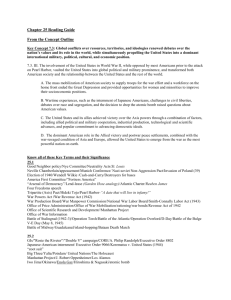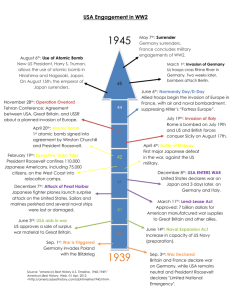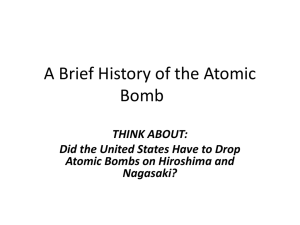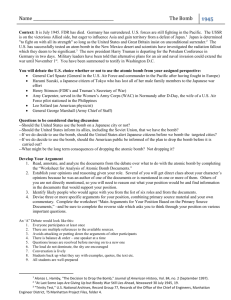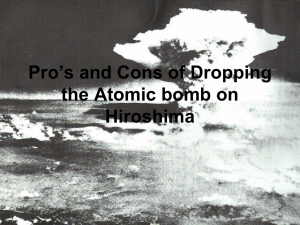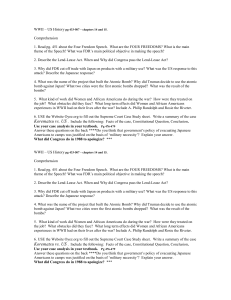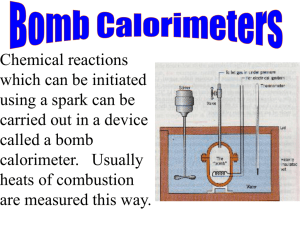The Atomic Bomb (Manhattan Project)
advertisement
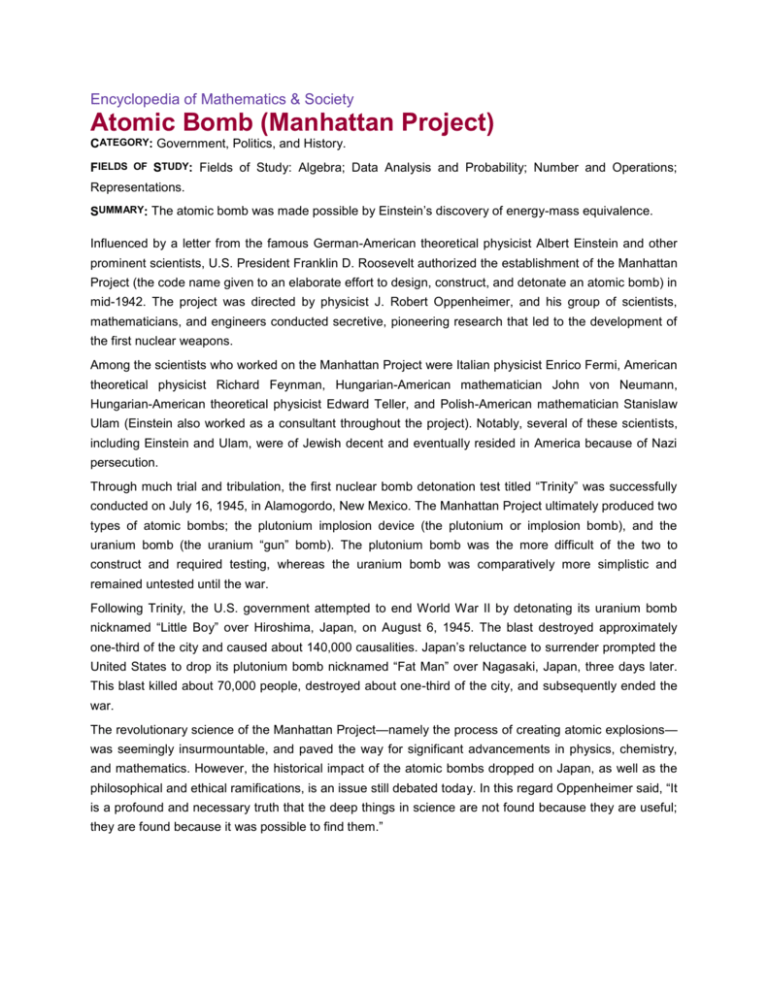
Encyclopedia of Mathematics & Society Atomic Bomb (Manhattan Project) CATEGORY: Government, Politics, and History. FIELDS OF STUDY: Fields of Study: Algebra; Data Analysis and Probability; Number and Operations; Representations. SUMMARY: The atomic bomb was made possible by Einstein’s discovery of energy-mass equivalence. Influenced by a letter from the famous German-American theoretical physicist Albert Einstein and other prominent scientists, U.S. President Franklin D. Roosevelt authorized the establishment of the Manhattan Project (the code name given to an elaborate effort to design, construct, and detonate an atomic bomb) in mid-1942. The project was directed by physicist J. Robert Oppenheimer, and his group of scientists, mathematicians, and engineers conducted secretive, pioneering research that led to the development of the first nuclear weapons. Among the scientists who worked on the Manhattan Project were Italian physicist Enrico Fermi, American theoretical physicist Richard Feynman, Hungarian-American mathematician John von Neumann, Hungarian-American theoretical physicist Edward Teller, and Polish-American mathematician Stanislaw Ulam (Einstein also worked as a consultant throughout the project). Notably, several of these scientists, including Einstein and Ulam, were of Jewish decent and eventually resided in America because of Nazi persecution. Through much trial and tribulation, the first nuclear bomb detonation test titled “Trinity” was successfully conducted on July 16, 1945, in Alamogordo, New Mexico. The Manhattan Project ultimately produced two types of atomic bombs; the plutonium implosion device (the plutonium or implosion bomb), and the uranium bomb (the uranium “gun” bomb). The plutonium bomb was the more difficult of the two to construct and required testing, whereas the uranium bomb was comparatively more simplistic and remained untested until the war. Following Trinity, the U.S. government attempted to end World War II by detonating its uranium bomb nicknamed “Little Boy” over Hiroshima, Japan, on August 6, 1945. The blast destroyed approximately one-third of the city and caused about 140,000 causalities. Japan’s reluctance to surrender prompted the United States to drop its plutonium bomb nicknamed “Fat Man” over Nagasaki, Japan, three days later. This blast killed about 70,000 people, destroyed about one-third of the city, and subsequently ended the war. The revolutionary science of the Manhattan Project—namely the process of creating atomic explosions— was seemingly insurmountable, and paved the way for significant advancements in physics, chemistry, and mathematics. However, the historical impact of the atomic bombs dropped on Japan, as well as the philosophical and ethical ramifications, is an issue still debated today. In this regard Oppenheimer said, “It is a profound and necessary truth that the deep things in science are not found because they are useful; they are found because it was possible to find them.” THE FIRST NUCLEAR REACTIONS Nuclear fission is the splitting of the nucleus of a heavy atom into smaller pieces, which releases a gigantic amount of energy. When this type of reaction is self-sustaining (it stimulates further reactions), it is called a “chain reaction.” A critical mass is the minimum mass of fissionable material needed to ensure that a nuclear reaction sustains a chain reaction. Achieving a critical mass and, ultimately, a chain reaction was the essential challenge in developing both Little Boy and Fat Man. The Little Boy design utilized the “gun method,” which was detonated by firing a mass of uranium-235 down a cylinder into another mass of uranium-235 to produce a chain reaction. Fat Man was an implosion-type device that used plutonium-239. In this design, plutonium was placed in the center of a hollowed-out sphere of high explosives, and a number of detonators located on the high explosive’s surface were simultaneously fired pressurizing the core and increasing its density—creating an implosion that resulted in a chain reaction. The Trinity test bomb was similar and was nicknamed “The Gadget.” Little Boy produced a blast of approximately 12,500 tons of trinitrotoluene (TNT). Fat Man had the explosive power of about 22,000 tons of TNT and The Gadget had a blast yield of around 15–20 tons of TNT. A tremendous amount of engineering, chemistry, physics, and mathematics was involved in the development and deployment of the atomic bombs. Among these fields was a branch of theoretical physics called “quantum mechanics” (the set of scientific principles that describe the behavior of matter and energy predominating at both the atomic and subatomic levels), which at the time was in its infancy. Quantum mechanics was developed under the assumption that energy is not infinitely divisible but rather composed of quanta (small increments). Unlike classical or Newtonian mechanics, which describes the motion of objects we encounter every day at the macrocosmic level, quantum mechanics deals with uncertainty in many of its results and is statistical and probabilistic in nature. Although initially this branch of physics was not readily accepted, it nonetheless proved an essential tool in the development of the atomic bomb as it provided many of the insights necessary for its construction. In regard to the science and mathematics utilized in the development of the bomb Stanislaw Ulam said, “It is still an unending source of surprise for me to see how a few scribbles on a blackboard or on a sheet of paper could change the course of human affairs.” Explosion resulting from the “Trinity” test of the plutonium bomb. (National Archives) THE ENERGY-MASS EQUIVALENCE One of the most imperative concepts in the development of the atomic bomb was the mathematical formulation of the energy-mass equivalence, which was derived by Einstein. He established that mass and energy are, in fact, both different manifestations of the same thing. This idea was a counterintuitive and revolutionary result that spawned from his 1905 special theory of relativity . Einstein’s formulation implied that very minute amounts of mass can be converted into excessively large amounts of energy. For example, this very encyclopedia is, in actuality, a form of energy in storage, which could equivalently be called rest energy or mass. If this encyclopedia could be completely converted into energy, it would yield a gigantic amount of energy indeed. This energy-mass equivalence concept is depicted symbolically through one of the world’s most famous equations: E = mc2. This equation is interpreted as the rest energy E of an object being equivalent to the mass m of the object multiplied by the square of the speed of light c in a vacuum. Alternatively, E = mc2 can be construed as the equation that allows one to determine the amount of mass needed to produce a certain amount of energy—assuming all of the mass can be converted completely into pure energy. To better understand how this famous simple equation was crucial in the development of the atomic bomb, one needs to understand its nature. First, E = mc2 is a “direct proportion” (E is directly proportional to m), and is symbolically expressed as E m. In general, a direct proportion has the form of where a is the proportionality constant. As a simple example: In this case, the proportionality constant is a=2, whereas in the energy-mass equivalence, the proportionality constant is c2. According to the International Bureau of Weights and Measures, the value of c is 299,792,458 meters per second (m/s), or about 186,282.4 miles per second (mi/s). For computational simplicity, c is often rounded to 300,000,000 m/s (186,000 mi/s), except when performing experiments that require exact values for light speed. Now, taking c=300,000,000 m/s = 3×108 m/s one can compute that 1 kilogram of plutonium could theoretically turn into Therefore, one can intuitively understand why a small amount of uranium or plutonium can generate explosions as massive as the ones produced by Little Boy and Fat Man. It is interesting to note that for the Trinity test, the mushroom cloud expanded to nearly 300 meters (about 984 feet) in .053 seconds. FURTHER READING Bird, Kai, et al. American Prometheus: The Triumph and Tragedy of J. Robert Oppenheimer. New York: Random House, 2005. Coster-Mullen, John. Atom Bombs: The Top Secret Inside Story of Little Boy and Fat Man. SelfPublished, 2003. Groves, Leslie M. Now It Can Be Told: The Story of the Manhattan Project. New York: Harper, 1962. Kelly, Cynthia C., et al. The Manhattan Project: The Birth of the Atomic Bomb in the Words of Its Creators, Eyewitnesses, and Historians. New York: Black Dog & Leventhal Publishers, 2007. Rhodes, Richard. The Making of the Atomic Bomb. New York: Touchstone, 1986. Serber, Robert. The Los Alamos Primer: The First Lectures on How to Build an Atomic Bomb. Berkeley: University of California Press, 1992. Sullivan, E. T. The Ultimate Weapon: The Race to Develop the Atomic Bomb. New York: Holiday House, 2007. Daniel J. Galiffa http://history.salempress.com/doi/abs/10.3331/math_103136901031?prevSearch=Galiffa&queryHash= 0d9c8a9df3e56c4391f1e94e491d88cb


